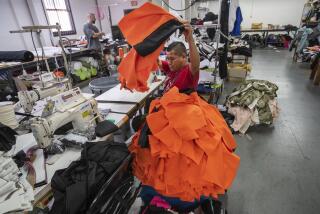Durable Goods Orders Off 0.6% for October
- Share via
WASHINGTON — Orders for durable goods, items ranging from refrigerators and automobiles to aircraft, inched down 0.6% in October after a revised 1.1% fall in September, the Commerce Department said Wednesday.
It said a 3% jump in transportation orders tempered the overall decline, which was propelled by a sharp fall in defense orders. Rising orders for ships and civilian airplanes more than offset a decline in auto production and parts.
Excluding the volatile transportation sector from both months, orders fell 1.8% in October after a 2.8% rise in September.
The October decline fell short of economists’ expectations of a steep 2.1% drop. The September order rate was revised down sharply from a previously reported rise of 0.2%.
Excluding defense orders, which fell sharply in October, durable goods orders rose a slight 0.5%. The September figure, exclusive of defense orders, showed a 3.5% fall.
Orders for military capital goods fell 12.4% in October after a 33.9% jump in September. Non-defense capital goods, boosted by transportation orders, rose 3.2% last month after a 4.7% fall in September.
Overall durable goods orders in October totaled $124.59 billion, compared to $125.33 billion in September.
Built to last three years or more, durable goods are a key part of the manufacturing sector, and orders for the big-ticket items are closely watched as an indicator of the economy’s health.
The department said shipments of durable goods last month fell by 1.7% following September’s 3% fall. Unfilled orders, an indicator of future activity, rose by 0.5% after a 0.2% gain the previous month.
The industrial sector has lately been under pressure, and that was reflected in the fall in orders for non-transporation goods. Manufacturing employment has dropped for seven straight months, durable goods orders have declined for two consecutive months, and industrial production has contracted sharply.
Although the Federal Reserve has eased credit to prevent the weakness from spreading, economists say interest rates could come down further if the economic slowdown persists. But the Fed is also treading a cautious path, fearful that looser credit could reignite inflation, which is running at a 4.6% rate so far this year at the consumer level.
Among other sectors, orders for electrical machinery and primary metals each fell 3.8%, while non-electrical machinery fell 4.6%.
“The U.S. manufacturing sector is in a recession. Very few industries are hiring, and most are laying off employees,” said John Hagens, chief economist for the WEFA Group, an economic forecasting company in Bala Cynwyd, Pa.
The open question, economists said, was whether the sluggishness in manufacturing would spill over into the rest of the economy and spell an end to the economic recovery, which has already lasted a peacetime record of seven years.
Cynthia Latta, an economist with DRI-McGraw Hill Inc., predicted that economic growth would dip below an annual rate of 1% in the final three months of this year, and she said economic activity would remain lackluster through the first half of 1990.
“We are not forecasting a recession but we are forecasting miserable growth. It is so close to the edge that the economy could slip into negative growth,” she said.
The last time the economy faced such an extended period of weakness was in mid-1986.
More to Read
Inside the business of entertainment
The Wide Shot brings you news, analysis and insights on everything from streaming wars to production — and what it all means for the future.
You may occasionally receive promotional content from the Los Angeles Times.










